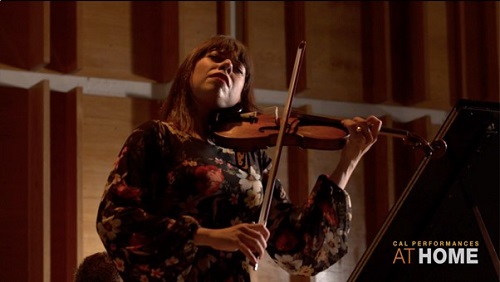 United States Bartók, Ysaÿe, Schubert, Grieg, Ravel, Tessa Lark (violin) and Andrew Armstrong (piano): Recorded at New York’s Merkin Hall for Cal Performances, 1.10.2020. (HS)
United States Bartók, Ysaÿe, Schubert, Grieg, Ravel, Tessa Lark (violin) and Andrew Armstrong (piano): Recorded at New York’s Merkin Hall for Cal Performances, 1.10.2020. (HS)

Bartók (arr. Székely) – Romanian Folk Dances
Ysaÿe – Sonata No.5 for Solo Violin in G major ‘Mathieu Crickboom’
Schubert – Fantasy in C major
Grieg – Violin Sonata No.3 in C minor
Ravel – Tzigane, rapsodie de concert
Organizations are seeking new ways to monetize music from select artists in a time when they cannot have live audiences, and are plowing new ground using technology. The University of California-based Cal Performances, one of the more active groups in the music-rich San Francisco Bay Area, launched Cal Performances at Home on Thursday with a solidly conceived and expressively played recital by violinist Tessa Lark.
From now through a 14 January recital by soprano Julia Bullock, a new concert every week will feature a feast of diverse artists and styles. These include the Tetzlaff Quartet, Natalie Joachim and the Spektral Quartet, early music artist Jordi Savall, cellist Yo-Yo Ma and jazz trumpet virtuoso Bria Skonberg. Viewers can get access for single performances for $15 to $60, depending on how many are watching (on the honor system); or opt to take the whole series for $225. Performances remain available on demand.
‘Musical Passports’, Lark’s hour-and-a-half concert recorded at Merkin Hall, used several cameras to keep it lively visually. She and pianist Andrew Armstrong collected pieces that felt like improvisations by composers riffing on musical material specific to their places of origin.
An arrangement of Bartók’s Romanian Folk Dances and Ravel’s Gypsy-infused Tzigane bookend the program. In between, Ysaÿe’s unaccompanied Sonata No.5 is a tribute to a fellow Belgian violinist, and Grieg’s Sonata No.3 makes extensive use of Norwegian folk songs. Schubert’s Fantasy in C major centers on the composer’s own ‘Sei mir gegrüsst’ (‘I greet you’), an early song that sets words by Rückert. Here it develops into a virtuoso set of variations.
The wide range of European musical styles, in terms of both geography and eras, plays to Lark’s ability to match her own style to a composer’s. That began with the opening work, as Bartók’s dances emerged with a distinctly eastern European twang from her violin and rhythmic bite. She met the intricate technical challenges of Ysaÿe’s sonata, fashioning the seven-minute work into a polished sculpture.
Andrew Armstrong, her collaborator on piano, provided note-perfect accompaniment and never got in the way. If his playing lacked the savory flavors Lark seemed to conjure easily, he kept pace and shaded dynamics in sync with the violinist. As a result, her playing drove the style and scored the excitement in the expansive Schubert Fantasy.
After a seven-minute intermission, the welcome simplicity of Grieg’s folksy sonata set up a big contrast to the final work. In Ravel’s lengthy opening violin cadenza, Lark reveled in every musically risqué twist and interpolated pizzicato, and finished the showpiece with a zing of a climax.
(In retrospect, it is too bad each of these works finish with a loud coda. One or two quiet endings would have been welcome.)
Between each piece, Lark spoke briefly and cogently on short videos about what inspired her about the piece she was about to present. After the Ravel, she playfully asked the audience to be seated and introduced an encore, her own ‘Appalachian Fantasy’. Lark grew up in Kentucky and also excels at bluegrass fiddling. This work juxtaposes an ‘Old Kentucky Home’ treatment of the Schubert song from earlier in the program against a drone; revs up a gradual accelerando to her own bluegrass ballad ‘Clara’ (a tune she says was inspired by Brahms); and finishes with a rousing version of ‘Bonaparte’s Retreat’, the piece that inspired Copland’s ‘Hoedown’.
It was another taste of a different flavor, and served as a vivid coda for a nicely varied concert.
Harvey Steiman
The performance is available for viewing on demand until 30th December by clicking here.